New methods of making chips allow them to be created with much smaller transistors and therefore fit more into the same area. This brings us to a simple question: why aren’t NVIDIA and AMD releasing scaled-down versions of their existing chips for the lower ranges? Well, this, even if you don’t believe it, has nothing to do with a marketing strategy, but with something that all fleas have, the so-called microbumps.
The logic of Moore’s Law is that if I have a square chip 10mm long, let’s set it to 10nm to keep things simple. So if I make a 7nm version of the same chip, it will become 7mm long and therefore grow from 100mm.2 area at 49mm2 and therefore it will have reduced its size by half. However, this is not possible because the chip must maintain its ability to communicate with the outside and unfortunately this part does not evolve in the same way. That is why we are going to introduce you to what microbumps are.
Why don’t we see CPUs, GPUs, SSDs or other smaller ones?
The arrival of big graphics cards like the RTX 4090 can lead us to ask ourselves a very logical question if we take into account how the evolution of chips works over time. Moreover, we tend to miniaturize things so that they take up less and less space. However, we don’t see any downsized memory modules, nor SSDs and CPUs either.
And we should logically see them, because having smaller transistors not only means making more complex chips, but also being able to reduce the size of existing ones. Let’s not forget that the specifications of many products are already good enough. Therefore, they have to find their appeal in another way and the normal thing would be to have more and more compact systems, instead we find that they are gradually disappearing.
And all this is not due to simple whims, but to the fact that when we generally talk about scaling chips, whether logic or memory, we are not talking about an element that has to do with the interconnection and communication of themselves.
What are microbumps on a chip?
Many of you have seen unsoldered chips that have a pin array at the bottom that are usually soldered to the board. Well, the job of these connections is to make the chip communicate with the PCB and therefore with other chips, voltage lines from the power supply, etc. These connections are the ones that later, when soldered to the board, look like little balls of copper, and are ultimately just connector pins. That’s why when it comes to undoing and redoing them, we call the process reballing. In fact, we should call it remicrobumping,
The problem is that they don’t scale in the same way as transistors, so if we reduce the size of the chip we will also have to take into account that we will have fewer connections available. This involves having to share microbumps for different functions, which ends up causing contention issues when accessing information. Bandwidth also cannot be maintained as this would mean increasing the clock speed of the interface and with it its voltage, power consumption and heat.
It is for this reason that when designing a chip such as the GPU of a graphics card or a new type of memory, the number of connections or microbumps is usually left fixed and with it the size of the chip. It is not intended to make a cheaper, smaller version of an already existing chip due to the issues we just discussed. This is why, for example, NVIDIA did not release its RTX 30 series from Samsung 8nm to TSMC 4nm. AMD neither with its RX 6000.
The problem of old chips
What happens with very old chips? Since it’s getting to the point where we have so few transistors to scale per area, it doesn’t make sense to build them on a more advanced node, because you end up paying more for the cost of the wafer without being able to benefit from a smaller transistor. This is why there are still factories with less advanced manufacturing nodes that manufacture less advanced ICs, but they are essential for a multitude of industries.
Also, part of the regionalization plans of not depending on Asian chip factories to build them in the European Union and the United States is not about creating the most advanced chip, but about moving of manufacturing themselves and control over production and logistics costs.
Finally, a trend has been towards integration, if a chip is too small to be manufactured in a more advanced process, then several adjacent chips are joined into one. It’s something we’ve seen in motherboards, where there are fewer and fewer chips, but the specs don’t drop.











